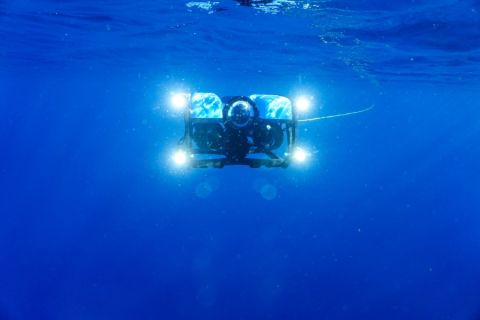The oil and gas industry has been carrying out Arctic research for decades, but there has been a resurgence of interest in the recent past that has pushed harsh-environment operations to the forefront.
Partnering for solutions
Recognizing the need to address Arctic challenges, ABS established a Harsh Environment Technology Center (HETC) in partnership with Memorial University of Newfoundland (MUN) in St. John’s, Newfoundland and Labrador, Canada, in 2010. The primary objective of the center is to develop technology for the design and assessment of ships and offshore structures that operate in harsh environments—particularly the Arctic and low-temperature areas. Research undertaken through HETC includes ice-hull interaction, ice loads on offshore units and winterization issues.
Contending with ice-hull interaction
Through HETC, ABS is contributing to projects in which full-scale structural arrangements close to Polar Class strengthening levels are being subjected to ice samples shaped as ice cones and loaded on hydraulic rams to more than 300 mt of force. The results of these tests are being used to validate numerical simulations of both ice and structural deformation. The information gained through testing is providing valuable insight to the plastic overload capacity of typical icebelt structures.
Dynamic experiments include high-energy collisions using a novel double pendulum collision apparatus capable of swinging more than 9 mt of ice and steel at a closing speed greater than 10 m/sec (33 ft/sec).
Managing ice loads
As Arctic offshore developments venture into deeper water, the industry will face new challenges related to the safety and station-keeping capabilities of floating structures subjected to global ice loads. HETC is managing the first phase of a joint industry project (JIP) aimed at closing knowledge gaps that exist in understanding ice loads on floating structures.
Workshops hosted in St. John’s have facilitated a comprehensive review of the subject, addressing different structural configurations, interaction scenarios, ice management, station-keeping systems, numerical models, model-testing procedures, design codes, full-scale data and operational experience. In the process, workshop participants identified a number of areas of uncertainty. These will be further explored to provide recommendations toward a dedicated full-scale measurement campaign that will be coupled with physical model testing and numerical modeling efforts that will target prioritized areas of development. The work will serve as a guideline for later stages of the JIP in which knowledge gaps will be addressed.
Traditionally, ice management has been an operational issue. Recently, however, the industry is taking a broader view of ice management. ISO 19906 provides the first comprehensive treatment of the subject in a standard and sets requirements for overall system reliability. Ice management systems typically consist of a series of processes and procedures such as detection/tracking/forecasting of ice conditions, threat evaluation, physical ice management, ice alert procedure and disconnection/move off from the site. For floating drilling systems—and potentially for production systems—physical ice management could include icebreaking, ice clearing or iceberg towing to reduce the station-keeping loads on a unit.
ABS has initiated a project aimed at developing novel technologies to quantitatively assess the effectiveness of physical ice management. The project includes performance models of ice breakers in various ice conditions and under different tactical maneuvers.
Accompanying software incorporating GPU hardware technology is being developed to carry out performance estimates and to visually display the simulation. The GPU environment provides a massively parallel domain for solving complex interactions among icebreakers, offshores structures and ice floes at hyper-real-time speeds. Currently, the simulation can run 12 times faster than real time, which enables the practical assessment of performance by simulation.
The development will continue in 2014 to include more complicated interactions such as floe splitting, floe submergence, rubble pile-up, mooring systems, etc.
Addressing winterization issues
One of the roles of a classification society is to understand industry’s changing safety needs and to develop guides that help to achieve safety goals. Recognition of the industry’s desire to move into harsher environments led ABS in 2006 to publish the Guide for Vessels Intended to Operate in Low-Temperature Environments (LTE Guide), which has since undergone multiple revisions based on industry feedback. The LTE Guide represents a set of mostly prescriptive requirements based on assumptions about vessel operations. The prescriptive nature of the LTE Guide is quite helpful in many scenarios, but for others with historical experience prescriptive requirements can contradict the proven service experience. So there is a clear need for an approach to safety that allows companies to demonstrate competence in dealing with risk without following prescribed action.
One way HETC is moving toward this goal is in developing a risk-based winterization approach that offers an avenue for owners and operators to comply with the intent of the LTE Guide in situations where it is neither practical nor feasible to meet certain prescriptive requirements. The developed methodology is a systematic approach to vessel design that delivers a low level of risk while permitting the use of practical solutions. This approach currently is being applied collaboratively with a designer to a new vessel design intended for harsh-environment operations where the operators have a long history of safe operations. Areas of noncompliance with the prescriptive requirements are being highlighted and risks evaluated based on probability and consequences of failure. The exercise is providing valuable feedback to ABS for the future enhancement of the LTE Guide and to the client for making informed decisions in the detailed design phase.
Developing the Arctic Operations Handbook
Another JIP established in 2012 and concluded at year-end 2013 has resulted in the Arctic Operations Handbook, which addresses safety and sustainability of offshore operations in the Arctic. The JIP, which is made up of 15 companies, focused on operational activities associated with transporting and installing fixed, floating and subsea units as well as dredging, trenching, pipelaying and floating oil and gas production in Arctic and cold-weather conditions.
The goal of the investigation into existing rules, regulations, standards and guidelines was to provide a common understanding for the offshore industry. Significant effort was expended to identify gaps in existing guidelines. A framework was defined early on to facilitate the identification of key aspects of safe Arctic operations. With that goal in mind, offshore operations were divided into subactivities to allow specific conclusions and recommendations to be reached. Potential risks that could arise in specific Arctic conditions were identified for each subactivity to improve the understanding of the operational challenges involved.
The project report, “Arctic Marine Operations Challenges and Recommendations,” provides a list of the identified gaps and a large number of recommendations that have the potential to close these gaps. Published in late 2013, the report provides an overview of what is required to prepare for and perform transport, installation and production operations in Arctic environments. The hope of the JIP is that specific recommendations will contribute to the development of internationally accepted standards and guidelines including ISO/TC67/SC8 (Arctic operations), ISO 19906 SC7 (offshore structures) and ISO 19901-6 (marine operations).
Recommended Reading
EOG: Utica Oil Can ‘Compete with the Best Plays in America’
2024-05-06 - Oil per lateral foot in the Utica is as good as top Permian wells, EOG Resources told analysts May 3 as the company is taking the play to three-mile laterals and longer.
E&P Highlights: May 6, 2024
2024-05-06 - Here’s a roundup of the latest E&P headlines, including technology milestones and new contract awards.
US Oil, Gas Rig Count Falls to Lowest Since January 2022
2024-05-03 - The oil and gas rig count, an early indicator of future output, fell by eight to 605 in the week to May 3, in the biggest weekly decline since September 2023.
Pemex Reports Lower 2Q Production, Net Income
2024-05-03 - Mexico’s Pemex reported both lower oil and gas production and a 91% drop in net income in first-quarter 2024, but the company also reduced its total debt to $101.5 billion, executives said during an earnings webcast with analysts.
Chouest Acquires ROV Company ROVOP to Expand Subsea Capabilities
2024-05-02 - With the acquisition of ROVOP, Chouest will have a fleet of more than 100 ROVs.




